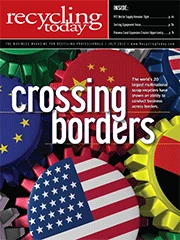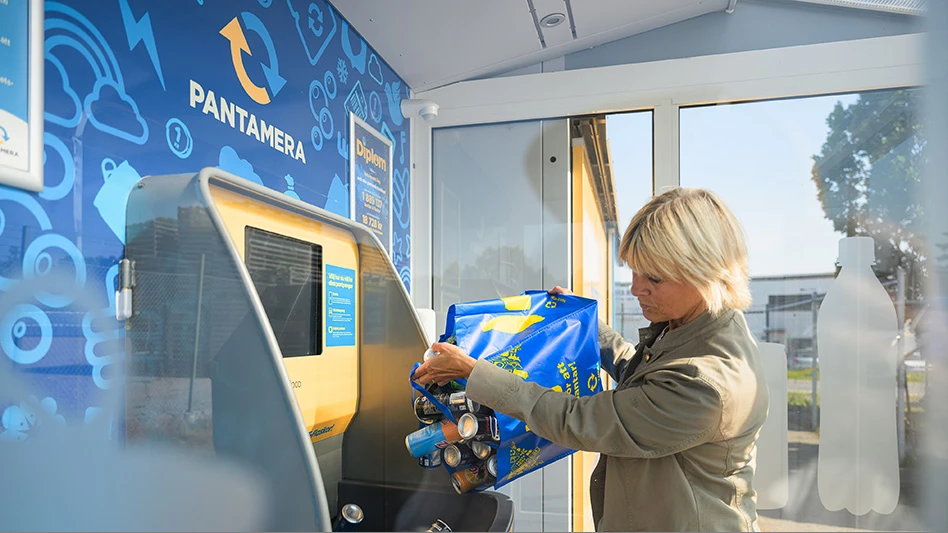 Demand for polyethylene terephthalate (PET) bottles and recycled PET (RPET) continues to outpace supply. With additional RPET production capacity coming online recently and announcements of future expansions on the part of companies such as US Fibers and Perpetual Recycling Solutions, demand is likely to continue exceeding supply, which will affect pricing for RPET and PET bales.
Demand for polyethylene terephthalate (PET) bottles and recycled PET (RPET) continues to outpace supply. With additional RPET production capacity coming online recently and announcements of future expansions on the part of companies such as US Fibers and Perpetual Recycling Solutions, demand is likely to continue exceeding supply, which will affect pricing for RPET and PET bales.
“The demand for bottles to recycle and RPET continues to grow in the market as more manufacturers and products continue to look for opportunities to create and promote sustainability and a green story regarding their product offerings,” Turner Plunkett, president of the board of directors at Clear Path Recycling LLC, Fayetteville, N.C., says.
Clear Path is a joint venture between Shaw Industries Group Inc. and DAK Americas LLC created to recycle post-consumer PET bottles to produce RPET flake. Shaw Industries is a carpet manufacturer and floor covering provider, while DAK Americas produces polyester staple fiber PET resin.
“Demand is always greater than supply,” says Dave Cornell, technical director of the Association of Postconsumer Plastics Recyclers (APR), Arlington, Va. He says government mandates, brands and economics drive demand for RPET.
While PET containers continue to grow in terms of market share, the recovery rate for this material has been holding fairly steady.
Supply Situation
According to the “2010 Report on Post Consumer PET Container Recycling Activity,” issued in late 2011 by the National Association for PET Container Resources (NAPCOR), Sonoma, Calif., in combination with the APR, the recycling rate for PET bottles and jars reached 29.1 percent in 2010. Of the 5,350 million pounds of PET bottles available for recycling in the U.S., 1,557 million pounds were recovered and sold for recycling that year. The amount of bottles collected for recycling increased by 113 million pounds in 2010 compared with 2009, the report sates, in light of an increase in the number of bottles available for recycling, a 50 million-plus increase in the weight of bottles collected through deposit program expansions in Oregon, Connecticut and New York, new curbside programs and commercial recovery efforts.
With the relatively flat recycling rate compared to the 28 percent achieved in 2009, reclaimers in the U.S. again needed to look outside of the U.S. for their supply, purchasing 89.5 million pounds of post-consumer bottles from Canada and Mexico as well as from South and Central America, NAPCOR says. “Domestic reclaimers also reported buying 20.3 million pounds of alternative feedstock, include pre-consumer bottles, post-consumer strapping and other unprocessed industrial scrap,” the report notes.
“The collection rate for bottles has been somewhat lackluster for the last 10-odd years,” says Steve Navedo, vice president of sales and quality assurance for East Farmingdale, N.Y.-based Pure Tech Plastics LLC, which largely produces RPET for direct-food contact applications. He is also a member of the APR board of directors.
To fulfill the available PET recycling capacity in the U.S., Navedo says the bottle recycling rate would need to be in the neighborhood of 40 to 50 percent. He estimates that the industry has a capacity utilization rate of from 65 to 70 percent currently. “At least 30 percent of the capacity is not being used.”
Dennis Sabourin, executive director of NAPCOR, says the nature of the plastic container stream has changed dramatically in the last few years with the growth of thermoform containers, which are formed from PET sheets. He estimates that thermoforms account for one-third of PET packaging, while bottles and jars account for two-thirds. He says much of the growth in PET container market share is in thermoforms, prompting NAPCOR and APR to dedicate efforts to growing the recovery of this material.
Navedo says that in an effort to get additional material for recycling, the industry has had to look to other areas, such as thermoforms. “We cannot afford to ignore that potential stream.”
Quality Concerns
Bale quality can tend to deteriorate when supply tightens, says Carlos Gutierrez, president and CEO of New United Resource Recovery Corp. (NURRC), Spartanburg, S.C. He says, “Suppliers here are not obliged to improve their quality” as long as buyers for Chinese consumers are sourcing material from the U.S. “The Chinese will buy anything.”
NURRC produces RPET for food-contact applications.
Quality problems, specifically with material from curbside programs, is further narrowing reclaimers’ already thin processing margins, Gutierrez adds.
Dennis Denton of ORPET, St. Helens, Ore., says it is a “known fact” that curbside material is more contaminated that PET bottles collected through deposit programs, which contributes to the regional nature of the U.S. plastics recycling industry. “You don’t want to haul contaminated material a long way,” he says.
ORPET is a partnership between private investors headed by Denton of Denton Plastics, Portland, Ore., and Tom Leaptrott and the Oregon Beverage Recycling Cooperative, a statewide industry cooperative and the predominant administrator of the Oregon bottle deposit law.
U.S. reclaimers told NAPCOR that their yield losses ranged from 24.4 percent for deposit bottles to 32.2 percent for curbside material in 2010, a marked increase from 2009.
With nearly half of the PET bottles recovered for recycling being exported to China for processing, quality and supply issues are likely to remain a problem for the foreseeable future.

China's Effect
“For the last several years, exports have exceeded domestic use of U.S.A.-collected material, with most going to China,” APR’s Cornell says. “China continues to be a major buyer and ultimate destination of U.S.A.-collected post-consumer material.”
China’s buying is having serious effects on domestic reclaimers, Navedo says, largely in the form of reduced domestic supply and higher prices for recovered material.
Buyers for Chinese reclaimers continue to set the tone for PET bale prices, particularly on the West Coast, sources say, which often makes material in that region more expensive than material on the East Coast. In addition, because of the trade imbalance between the U.S. and China, shipping costs are often more favorable from the West Coast to China than to many U.S. destinations. Sabourin says, “It costs less to export baled bottles to China than to transport that material by truck to major markets in the U.S. from the West Coast.”
So far this year, China’s role in the PET bottle market has been less pronounced than in recent years, sources say.
Plunkett says, “The Chinese have been slowing their bottle purchasing in the past few months. Their demand has decreased related to their economy. This combined with seasonal increases in bottle consumption are delivering some softening in price.”
Pricing Parameters
Plunkett say pricing has been trending downward since spring and is expected to flatten this summer. “RPET flake will follow bottle pricing and will be influenced by the pricing of virgin PET,” he adds.
Gutierrez says the price of PET bales from curbside programs in his region has declined in recent months, selling for 20-odd cents per pound as of mid-June. “In the past year, it reached 41 cents per pound,” he adds. However, given the yield loss from these bales, Gutierrez says his company was really paying closer to 70 cents per pound for material.
Cornell adds, “Prices over the last five years have varied significantly.” He notes that in the last year, PET bale prices have ranged from the 20s into the 30s on a per-pound basis.
He says he’s hopeful that bale quality will improve as prices decline in light of China’s pullback from the market.
Cornell adds, “Flake prices will reflect purity and competitive costs versus virgin for a given application.”
According to NAPCOR’s 2010 report, bales of good quality, dirty granulate and bales of deposit bottles were in high demand and short supply, commanding a premium of 10 cents per pound compared with curbside bales.
The limited supply of recovered containers and China’s influence on pricing for available material concern Navero, he says. “My fear is that if recycled PET does get to the point that the supply is so limited, pricing will continue to increase. It is not good for recycled to cost more than virgin resin. As green as people may want to be, if your supply costs more than virgin, people are only going to be green to a certain point.” Navero adds, “We need to get supply up to stabilize pricing.”
Denton says many factors affect pricing for PET bales and RPET, including shortages of other materials. He cites the problem with cotton crops a year ago, which led to increased demand and pricing for polyester and RPET.
“Economic viability” also is at play, he says. “With the price of resin going the way oil goes, brand owners are looking for alternative sources to reduce costs.”
He adds, “The ultimate answer is having the public buy into recycling and want more recycled materials.”
The author is managing editor of Recycling Today and can be contacted at dtoto@gie.net.
Get curated news on YOUR industry.
Enter your email to receive our newsletters.

Explore the July 2012 Issue
Check out more from this issue and find your next story to read.
Latest from Recycling Today
- Nucor expects slimmer profits in early 2025
- CP Group announces new senior vice president
- APR publishes Design Guide in French
- AmSty recorded first sales of PolyRenew Styrene in 2024
- PRE says EU’s plastic recycling industry at a breaking point
- Call2Recycle Canada, Staples Professional expand partnership
- Circular Services breaks ground on north Texas MRF
- Tariff uncertainty results in choppy nonferrous scrap flows





